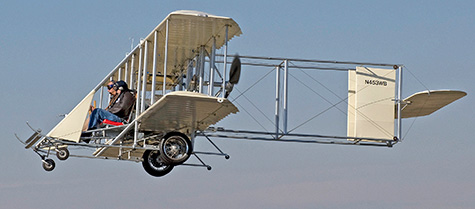Pilot Briefing
Pilots fly above disabilities
There’s nothing unusual about two pilots enjoying spectacular scenery above a thin cloud layer on a moonlit night, except these pilots both are disabled by spinal injury. Heather Schultz, 26, is a quadriplegic, although she can walk with a cane and electronic devices, while Sean O’Donnell, 32, has lost the use of his legs.
The pair flew in a two-place Sky Arrow 600 light sport airplane fitted with hand controls on a 1,000-mile Freedom Flight to raise awareness that flight-training scholarships are now available for wounded veterans. (Wounded veterans who are interested in flight training should visit the website.)
They stopped along the way to raise money in three towns for the scholarships to be administered through Able Flight, a North Carolina-based organization that provides flight-training scholarships for disabled people.
 The two ranked the moonlit clouds among their best memories since earning pilot certificates. O’Donnell, who lost the use of his legs in a motorcycle accident at age 17 as a high school senior, got his sport pilot certificate with a scholarship from Able Flight when he was 30 and continued to earn a private certificate. Schultz got her sport certificate more recently, using O’Donnell’s Sky Arrow and instructors at Purdue University. Purdue aviation officials wanted to learn how to provide flight instruction for disabled pilots.
The two ranked the moonlit clouds among their best memories since earning pilot certificates. O’Donnell, who lost the use of his legs in a motorcycle accident at age 17 as a high school senior, got his sport pilot certificate with a scholarship from Able Flight when he was 30 and continued to earn a private certificate. Schultz got her sport certificate more recently, using O’Donnell’s Sky Arrow and instructors at Purdue University. Purdue aviation officials wanted to learn how to provide flight instruction for disabled pilots.
O’Donnell started a flight school in Wilmington, Delaware, called Philly Sport Pilot that trains disabled and able-bodied pilots to fly. So far, his school has trained five disabled people, and one without disabilities. The disabled pilots were funded by Able Flight scholarships.
Schultz was injured when she dove into a pool during a party four years ago. Just the impact of hitting the water broke her neck. Her friends didn’t realize she was in trouble and she nearly drowned. Then they left her on a bed in the house for hours before calling for help. She has damage to all four extremities, but can walk with the aid of an electric switch under one of her heels that sends electrical stimulation to her left knee.
She was two weeks away from preparing for a career in nuclear medicine when the accident occurred. Her injuries prevent her from pursuing that career.
“I had no prior interest in flying, but I play wheelchair rugby at a rehabilitation center. The wheelchair sports director told me about the Able Flight opportunity,” Schultz said. Asked what flying means to her, she said, “It’s a huge responsibility—a lot more than driving a car. It was a little intimidating, and still is.” Now, she is developing an interest in aviation management.
O’Donnell was director of distance learning at Villanova University when he decided he had the resources and time to fly. His injury resulted when a car turned in front of him while he was riding a motorcycle. He happened to notice the Able Flight website on the very day that the organization formed, and became its first scholarship winner.
Able Flight, headed by Charles Stites, was formed in 2006 and has granted 32 scholarships that provide either full pilot certificates or flight experiences. Of the 21 full scholarships, 15 applicants have become pilots. Three dropped out, while others are still in training. Some of the applicants were returning to flying after an injury.
LSA NEWS
Piper Aircraft drops the PiperSport
No one is saying exactly why Piper Aircraft and Czech Sport Aircraft parted ways, but the PiperSport Light Sport aircraft (LSA) is no more. Piper Aircraft ended its association with the aircraft (see “Out in the Cold”).
Czech Sport Aircraft officials said in an unattributed statement that there was disagreement over whether to market the aircraft, formerly known as the SportCruiser, to the world or just to the United States. Piper officials said only that there were philosophical differences.
Sales and marketing official Russ Greenberg, who joined Piper eight years ago and most recently was in charge of PiperSport sales, is leaving Piper Aircraft as a result of the action. Light Aircraft Manufacturers Association President Dan Johnson reported on bydanjohnson.com that PiperSport had jumped to the second-best-selling LSA in the United States. The Flight Design CT has held the top spot almost continuously since the LSA industry began six years ago.
Distributor Don Ayres, who was the sole importer for the other 12 U.S. dealers, said he will continue to import the SportCruiser. His company is U.S. Sport Aircraft of Fort Pierce, Florida. Piper’s contribution was to help set up a sales network. Only one change was made in the aircraft during the year following Piper’s relationship with the Czech aircraft company, and that was to beef up the nose gear strut, but Ayres said that improvement was in progress prior to Piper’s involvement.
The remaining dealers formed an association to continue to sell and support the aircraft, and to establish a parts supply in Florida—something that wasn’t done after Piper and Czech Aircraft Works signed an agreement in January 2010.
The company vows to offer a new model sometime in the future with several improvements, but in the meantime dealers have a few Piper-Sport aircraft in stock remaining to be sold.
Czech airplane is newest LSA
 The DirectFly Alto airplane from the Czech Republic is the latest Light Sport aircraft to receive approval for the U.S. market. It will be distributed by Corbi Air in Salem, Ohio, and is aimed at flight schools.
The DirectFly Alto airplane from the Czech Republic is the latest Light Sport aircraft to receive approval for the U.S. market. It will be distributed by Corbi Air in Salem, Ohio, and is aimed at flight schools.
Flight schools will find the fly-away price to be about $112,000 depending on options chosen. Owner-pilots can purchase an upgrade package including wheelpants and luxury leather seats, as well as upgraded avionics, and can expect to pay between $115,000 and $120,000 with such options.
Standard equipment includes a Mode S transponder, internal corrosion protection, electric pitch and aileron trim, nosewheel steering, Teflon-coated aviation-grade wiring, Vertical Power’s electrical distribution system, and a U.S.-made Sensenich composite propeller with its stainless-steel leading edge. Another unique feature is the U.S.-supported Beringer wheel and anti-skid brake assemblies to prevent flat spots on tires.
Gobosh sold to Denver investors
Gobosh Aviation, which imports the all-metal Polish Aero AT–4 under the name Gobosh (the letters of the name stand for “Go Big or Stay Home”), has been sold to three Denver-area investors. The Gobosh ranks sixteenth in sales in the U.S. light sport aircraft (LSA) market, with 26 sold through December 2010. The AT–4 is the LSA version of the Aero AT–3 aircraft sold in Europe.
One of the investors, Chris Dillis, also owns a flying club, Skyraider Aviation, with locations in north and south Denver. The Gobosh import and sales business, as yet unnamed, will operate as a separate entity from the Skyraider Aviation flying club and have a separate office at Centennial Airport. The investors are concluding the deal under the name Aerospace Capital Partners LLC, a name that will change to include the Gobosh brand.
Initial efforts will be to import the Aero AT–4, sold in this country as the $130,000 Gobosh 700. There is also a Gobosh 800, the light sport version of the all-composite Aveko aircraft built in the Czech Republic that was considered a “luxury” LSA.
“We haven’t addressed the 800. We will support the 800 with spare parts,” said Dillis. He said he plans to explore cost-saving measures that could reduce the price of the aircraft, although at $130,000 it is less than some of the leading brands. One reason for the effort to reduce the price of the aircraft is to attract buyers from the training industry.
“In order to remain viable,” Dillis said, “flight schools will need a quality light sport aircraft that will appeal to students and instructors alike.”
Rare Twin Mustangs preparing for flight
Put EAA AirVenture 2013 on your calendar. That’s the year two North American Twin Mustangs may return to flying condition and go on display in Oshkosh. It got its name from the design, which looks like two North American P–51 Mustang fighters attached side-by-side.
One is powered by Allison engines and is owned by an individual who would rather not have his project in the spotlight until it is
completed.
The other is powered by the famous Rolls-Royce Merlin engine and was the first Twin Mustang to fly, the XP–82-NA. It is owned by Tom Reilly of Douglas, Georgia, who is performing the work with friends under a company called B–25 Group, LLC. He also operates Tom Reilly Vintage Aircraft and has restored 10 North American B–25 Mitchell bombers and several Boeing B–17s, including Liberty Belle.
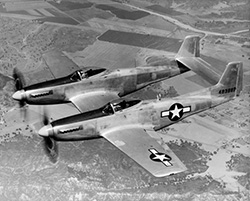 Twin Mustangs emerged from the factory too late for World War II, but were flown in the Korean War and were later used for ramjet testing and icing research in the 1950s by the National Advisory Committee for Aeronautics (NACA), succeeded by NASA.
Twin Mustangs emerged from the factory too late for World War II, but were flown in the Korean War and were later used for ramjet testing and icing research in the 1950s by the National Advisory Committee for Aeronautics (NACA), succeeded by NASA.
Reilly and his crew have invested two and a half years in the restoration of the aircraft, which first flew April 15, 1945. That includes preserving graffiti found from the time of manufacture, including a message from one worker to another saying, “I’ll bring in the theater tickets tomorrow.” He estimates another 18 to 24 months of work will be required. A third Twin Mustang once owned by the Commemorative Air Force has gone to the U.S. Air Force Museum after a legal battle.
Reilly said he was fortunate to locate a Merlin engine found in the garage of a home in Mexico City. Both his aircraft and the other one in restoration will use modern MT composite propellers. The propellers use a Kevlar cover over beech and spruce wood cores. The special spruce wood required is grown only at elevations between 6,800 feet and 10,500 feet. The beech wood is compressed in a 10-ton press to increase its density. American distributor Flight Resource said the four-blade propellers will have a diameter of 11 feet and be fully featherable, yet retain the period look of the original propellers.
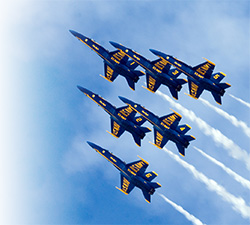 Say Again?
Say Again?
Test yourself with these aviation quiz questions
By AOPA Pilot staff
- What was the original name for the U.S. Air Force aerial display team later known as the Thunderbirds?
- What was the first aircraft flown by the Thunderbirds?
- What was the first supersonic aircraft used by the Thunderbirds?
- What two types of propeller-driven aircraft were flown by the U.S. Navy Blue Angels?
- What was the first jet aircraft flown by the Blue Angels?
- What was the first supersonic aircraft flown by the Blue Angels?
- What was the only type of aircraft ever flown by both the Blue Angels and Thunderbirds?
UAVs to fly at Kansas airport
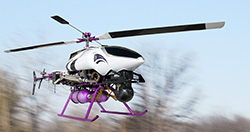 Forty- to 50-pound unmanned aerial vehicles (UAV), both aircraft and helicopter models, will soon fly from Captain Jack Thomas/El Dorado Memorial Airport, Kansas, under two certificates of authorization (COA) from the FAA.
Forty- to 50-pound unmanned aerial vehicles (UAV), both aircraft and helicopter models, will soon fly from Captain Jack Thomas/El Dorado Memorial Airport, Kansas, under two certificates of authorization (COA) from the FAA.
A company called Flint Hills Solutions will build and operate UAVs at the airport, and train customers on their use. FAA spokesman Les Dorr said other airports also have UAV operations, but he wouldn’t identify them. “As of December 1, 2010, there were 273 active COAs, but not all necessarily involve use of airport facilities,” Dorr said. All the COAs involve unmanned vehicles, he said.
Flint Hills Solutions will manufacture unmanned fixed-wing and helicopter vehicles at the airport. The authority to operate UAVs was given to the city of El Dorado, located near Wichita, not the airport. The FAA does not certify airports for UAV operations, but rather certifies organizations—including governmental entities—for such operation.
 Airport Manager Caleb Marsh noted that the El Dorado airport is not busy, and called the arrangement a good deal for the city and the airport. Under the agreement, the city can back out of the deal should conflicts arise with existing airport traffic.
Airport Manager Caleb Marsh noted that the El Dorado airport is not busy, and called the arrangement a good deal for the city and the airport. Under the agreement, the city can back out of the deal should conflicts arise with existing airport traffic.
The COA allows the city to use defined airspace for specified times and includes special provisions unique to each operation. COAs require coordination with an appropriate air traffic control facility (Wichita air traffic control). The city has designated Flint Hills Solutions to supervise the UAV operations.
“El Dorado airport will be a superior place for UAS operations and is perfectly situated 30 miles from Wichita, Kansas, that allows for training and operations outside of Class B, C, or D airspace,” said Roger Powers, president and CEO of Flint Hills Solutions.
‘New’ Wright B model flying
A one-of-a-kind airplane designed to highlight Dayton’s aviation heritage around the world has made brief hops off the ground and is ready for a formal flight test program this spring. Volunteers built it.
Since October 2010, volunteer test pilots have put Wright B Flyer No. 002 through a series of low- and high-speed taxi tests at Dayton-Wright Brothers Airport, where Wright B Flyer Inc. has its hangar and museum. Pilots also have made 76 brief hops in which the airplane rose several feet into the air but remained above the runway. It will cruise at 70 mph.
Dubbed the Silver Bird because of its silver-painted steel frame, the airplane is built to modern standards but resembles the Wrights’ first production flyer, the Model B. It has been in development since 2007, when the organization decided it needed a second Model B lookalike that was easy to ship, assemble, and fly at international events.
The organization’s flagship Model B, Brown Bird, has been flown at events across the United States and shipped as far as Berlin, Germany, for displays. But tearing it down, shipping it, and making it flyable again is expensive and takes a large crew of skilled volunteers.
“This airplane extends our reach in promoting our aviation heritage and Ohio’s aerospace business. We used to have regional markets. We have a global market today, and there’s no place in the world we can’t take this airplane,” said John Bosch, chairman of Wright B Flyer’s board of trustees.
“This plane is a great marketing tool for the National Aviation Heritage Area, as it has the portability to allow people anywhere in the world to experience the accomplishments of the Wright brothers and the airplanes they built here in Dayton,” said Tony Sculimbrene, executive director of the National Aviation Heritage Alliance.
Diesel engine reaches 500 horsepower
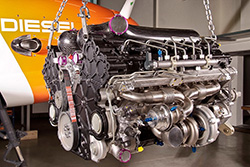 Raikhlin Aircraft Engine Developments (RED), a new venture founded by Wladimir Raikhlin and associates, has flown a 500-horsepower diesel engine on a modified Yak 52. The propeller for the water-cooled, 12-cylinder RED A03 engine is gear-driven.
Raikhlin Aircraft Engine Developments (RED), a new venture founded by Wladimir Raikhlin and associates, has flown a 500-horsepower diesel engine on a modified Yak 52. The propeller for the water-cooled, 12-cylinder RED A03 engine is gear-driven.
It was built by RED Aircraft GmbH in Adenau, Germany. The engine generates 500 horsepower during takeoff at 3,900 rpm. The engine weight at the moment is 705 pounds, according to diesel engine consultant Andre Teissier-duCros. The official weight is dependent on completing development, and is “to be announced.”
The engine will first be certified in Europe. Any changes required during development could increase the weight. The engine is intended to bridge the gap between piston engines and turboprop engines.
Teissier-duCros said that the weight marks this as a very good diesel engine, although not a breakthrough. The engine must still prove its reliability in all conditions, and any problems could mean a modification and additional weight. Teissier-duCros said he expects development in the future of a 600-horsepower diesel engine.
Road and Runway Rally to air on ‘MotorWeek’
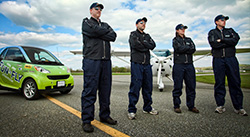 Last April, as part of the 2010 Fun to Fly Sweepstakes, we pitted our Remos GX light sport aircraft in a race against a smartfortwo Smart Car in a rally to Sun ‘n Fun in Lakeland, Florida. All bets were on the aircraft, but, as fate would have it, one of the tires went flat before takeoff. And that began an odyssey down the East Coast for our two teams—named Team Wilbur and Team Orville by a poll of our members online. Team Wilbur, Flight Training Deputy Editor Ian J. Twombly and MotorWeek correspondent Steve Chupnick—and Team Orville, AOPA ePilot Managing Editor Alyssa J. Miller and Wired.com correspondent Jason Paur—spent four days in the air and on the road, visiting general aviation airports, fantastic and unusual hotels (see “Fly Outs: Wings Over the Vines,” page 106), and meeting supporters and friends. MotorWeek will air “Over the Edge: Smart Vs. Plane” on PBS stations beginning February 12. The segment will appear on Discover HD Theater beginning February 22, and will be available online (pbs.org) starting February 28. Neither team really won the rally—although the spectacle of the car and airplane racing down the runway last year in Lakeland was a win for everyone, especially MotorWeek’s Chupnick, who landed his first GA airplane during the trip. —Julie Summers Walker
Last April, as part of the 2010 Fun to Fly Sweepstakes, we pitted our Remos GX light sport aircraft in a race against a smartfortwo Smart Car in a rally to Sun ‘n Fun in Lakeland, Florida. All bets were on the aircraft, but, as fate would have it, one of the tires went flat before takeoff. And that began an odyssey down the East Coast for our two teams—named Team Wilbur and Team Orville by a poll of our members online. Team Wilbur, Flight Training Deputy Editor Ian J. Twombly and MotorWeek correspondent Steve Chupnick—and Team Orville, AOPA ePilot Managing Editor Alyssa J. Miller and Wired.com correspondent Jason Paur—spent four days in the air and on the road, visiting general aviation airports, fantastic and unusual hotels (see “Fly Outs: Wings Over the Vines,” page 106), and meeting supporters and friends. MotorWeek will air “Over the Edge: Smart Vs. Plane” on PBS stations beginning February 12. The segment will appear on Discover HD Theater beginning February 22, and will be available online (pbs.org) starting February 28. Neither team really won the rally—although the spectacle of the car and airplane racing down the runway last year in Lakeland was a win for everyone, especially MotorWeek’s Chupnick, who landed his first GA airplane during the trip. —Julie Summers Walker
New company to build diesel engine
This may be the first time you have heard of Engineered Propulsion Systems, formed in 2006 in New Richmond, Wisconsin, but it won’t be the last. The firm has raised funding to begin development of a diesel engine for general aviation aircraft and helicopters.
A patent filed by the company shows a “hybrid” engine, meaning that it is made of varying materials. It has a ferrite load-bearing skeleton, and a nonferrite exoskeleton. There was no information in the patent as to what material will be used for the exoskeleton. The engine is based on a BMW 1.4-liter automobile engine.
In mid-November 2010, the company received $600,000 from Wisconsin’s Community Development Block Grant-Economic Development Program. In addition, the company received $222,000 from the New Richmond Angel Investment Network, and $125,000 from the Chippewa Valley Angel Investors Network. The company has previously reported it expects to spend $41.7 million on the project.
Aviation pioneer Dick Rutan is a technical advisor to the company. The company hopes to show a running prototype of the engine by June 2011.
Say Again? Answers
- The Skyblazers represented U.S. forces in Europe in the late 1940s and early 1950s. Two of the original members of the Skyblazers, identical twins C.A. “Bill” and C.C. “Buck” Patillo, went on to become original members of the Thunderbirds.
- F–84G Thunderchief.
- F–100 Super Sabre, in 1956.
- F6F-5 Hellcat (1946), F8F Bearcat (1946-1952).
- Grumman F5F-Panther (1950).
- Grumman F11F-1 Tiger.
- McDonnell Douglas F–4 Phantom II (Blue Angels: 1969-1974, Thunderbirds 1969-1973).
Do you have suggestions for aviation quiz questions that will stump other pilots? Send your questions to [email protected].
